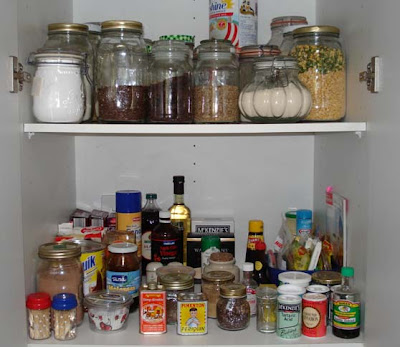A stockpile is a large amount of non-perishable food, cleaning products and toiletries that are purchased at sale price and stored in a cupboard until needed. I started my food and groceries stockpile by allocating $5 from my grocery budget for items on sale. I only ever bought things I knew I'd use and what would keep for a reasonable amount of time. The larger the stockpile became, the less I shopped, because I already had most of what I used at home. Now I shop about once a month for staples, and once a week I buy fresh milk and whatever fruit or vegetables I need that we're not growing in our backyard.
I'd like to point out that a stockpile cupboard is not a pantry. Above is a photo of my pantry cupboard. In the pantry I keep food that is currently being used. My stockpile cupboard (pictured below), which is not in my kitchen, holds food and groceries that have not been opened. It's like my mini-supermarket that is open all hours.
Alternatively, if you can afford it, allocate a set amount for your stockpile. Sit down and work out what your family uses and eats. Look at your menu plan and your grocery list and write a list of every item that will sit on a shelf for a long time without an ill effects. Turn yourself into a squirrel - stockpile those items that are on sale, go searching in your neighbourhood for bargains and when you find something, snap it up and add it to your cupboard. Remember that stockpiling is an ongoing process so don’t be upset if you can’t start with a bang. Go at it steadily so that you are sure that what you have is really what you need.
Start with things like:
- toilet paper, toothpaste, tooth brushes, tissues, tampons, shampoo, conditioner, soap, or whatever toiletries you use;
- anything canned - chick peas, beans, tomatoes, fruit, fish, condensed or evaporated milk (good for desserts and treats) etc.;
- anything dry - pasta, beans, lentils, rice, milk, flour, sugar, spices, oatmeal, cornmeal, tea, coffee, dried fruit;
- things in jars - honey, jam, pasta sauce, Vegemite, tomato paste;
- cleaning and laundry items: supplies for homemade laundry soap (soap flakes, washing soda and borax), white vinegar, bicarb soda. These items are kept in a separate cupboard;
- medical supplies: aspirin or paracetamol, bandaids, peroxide, tea tree oil, antiseptic wipes or cream, any medication your family needs - asthma puffers, contraceptive pill etc.
Only you know what you'll need. Study your buying habits and start putting away those items you buy every week that have a good shelf life, as well as those you use occasionally. Of course, one of the great side effects of stockpiling is that theoretically, you should never have to pay full retail price for anything in the stockpile. By stocking your cupboard with marked down groceries and sale items, you can "shop" from your stockpile, knowing that you're paying less than most other people who are shopping each week. So always keep your eye open for bargains and, when you have a chance, stock up on every item you use. If you can buy 20 cans of tomatoes for $5 (25c/can) and have them sitting in your cupboard waiting for the day you make spaghetti sauce or tomato relish, it's better than rushing out to the supermarket and paying full price for that same item, in my case 89 cents to one dollar for normal retail canned tomatoes. By the time your 20 cans of tomatoes are used, they will have come on sale again, you should grab them and replenish your stockpile.
Just a quick word on dried goods. When you bring home things like flour, rice etc., whack it in the freezer for a week or so to kill any pantry moth larvae it might contain. Always make sure you put dried goods in a sealed container when you open them as well. It's better to be safe than sorry. Remember when you add to your stockpile to add goods to the back and take from the front. Doing this will help you rotate your stock. Always be guided by the “best before” or “use by” dates if your groceries have them. If they do, remember that they will need special attention and must be used before those dates.
Just a quick word on dried goods. When you bring home things like flour, rice etc., whack it in the freezer for a week or so to kill any pantry moth larvae it might contain. Always make sure you put dried goods in a sealed container when you open them as well. It's better to be safe than sorry. Remember when you add to your stockpile to add goods to the back and take from the front. Doing this will help you rotate your stock. Always be guided by the “best before” or “use by” dates if your groceries have them. If they do, remember that they will need special attention and must be used before those dates.


